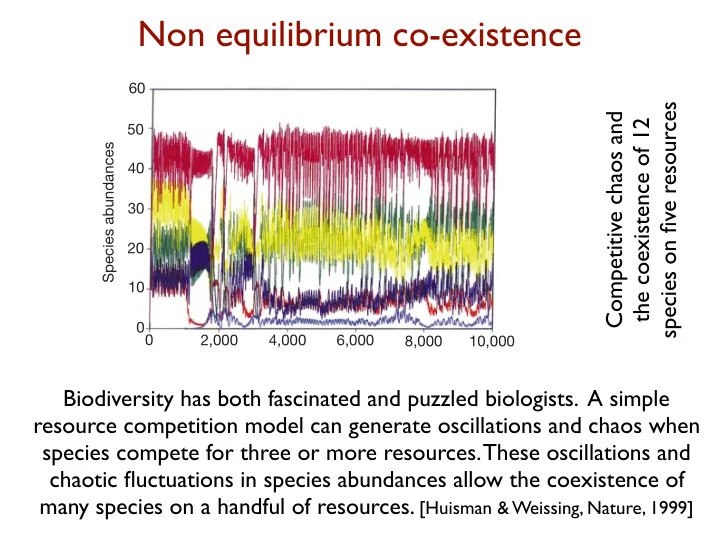

Non equilibrium co-existence a 60 species on five resources Competitive chaos and the coexistence of 12 50 Species abundances 40 30 20 10 0 0 2,000 4,000 6,000 8,000 10,000 Biodiversity has both fascinated and puzzled biologists. A simple resource competition model can generate oscillations and chaos when species compete for three or more resources. These oscillations and chaotic fluctuations in species abundances allow the coexistence of many species on a handful of resources. [Huisman & Weissing, Nature, 1999]
Density dependent predation
CRISPR mediated immunity Bacteria pick up DNA fragments from phages. They ‘store’ these fragments in their own genome to become immune to phages expressing these sequences [Levin et al . PLoS Genetics 2013]
Group formation and predator-prey dynamics Lions living in groups have a lower food intake but have better stability. But is this an ESS? [Fryxell et al . Science, 2007]
Nature 1997 We find that whereas the two separate, single host-single parasitoid interactions are persistent, the three-species system with the parasitoid attacking both hosts species (which are not allowed to compete directly) is unstable. One of the host species is eliminated owing to the effects of apparent competition. Also study equal predation
Competitive exclusion and parasitism We studied the effect of a pathogen on winning species: � = bN j (1 − N j /k ) − d j S j − β S j I j S j � = β S j I j − ( d j + δ ) I j I j Janzen-Connell hypothesis: parasites evolve towards most dominant species (negative density dependence) [Bagchi et al ., Nature, 2014] What is the effect of pathogens on co-existence?
Symmetry breaking in ecological systems through different energy efficiencies of juveniles and adults Persson & De Roos Ecology 2013; De Roos & Persson, Princeton UP , 2013 Ontogenetic development for dummies, try to repeat these results with: R = K − c 1 J − c 2 A , d J h 2 + R − mJR eAR d A d t = mJR d t = h 1 + R − µd 1 J and h 1 + R − µd 2 A
Long term effects of vaccination Getz, PLoS Biol 2009 The effect of elephants is through regular browsing and coppicing of trees, fire through episodic burns linked to fuel load, wildebeest after being released from the suppressing effects of endemic rinderpest (a morbillivirus of artiodactyls), and rain through its connections to all system components. Holdo et al. [2009] demonstrate that eradication of rinderpest is responsible for the Serengeti switch from a net source to net accumulator of carbon.
Early-warning signals for critical transitions a Biomass (a.u.) 6 F 1 4 F 2 2 0 b Residual 0 c Increasing the harvest rate over time Ecosystems can have tipping points at which a sudden shift to a contrasting dynamical regime may occur. Although predicting such critical points is extremely difficult, generic early-warning signals may indicate that a critical threshold is approaching [Scheffer Nature 2009]
Large-amplitude cycles of Daphnia and its algal prey in enriched environments McCauley et al Nature 1999 2 R f ( R ) = � H + R + ( H + R ) 2 − 4 γ HR
Tilman’s competition model: famous 1982 Princeton book, and PNAS 1997 What is the relation between diversity and productivity? See also recent experimental tests: Dybzinski & Tilman, American Naturalist 2007 & Adler et al. Science 2011
Tilman’s metapopulation model Nature 1994 p i Patches occupied: ¯ m 2 m 1 m 2 ↑ c 2 c 1 m 1 ( c 1 + c 2 ) − m 2 c 2 P c 1
Influenza strain replacement Mapping the Antigenic and Genetic Evolution of Influenza Virus Derek J. Smith, 1,2 * † Alan S. Lapedes, 3 * Jan C. de Jong, 2 Theo M. Bestebroer, 2 Guus F. Rimmelzwaan, 2 Albert D. M. E. Osterhaus, 2 Ron A. M. Fouchier 2 * Study strain replacement within a season, and how this depends on the vaccine coverage at the start of the season.
Recommend
More recommend